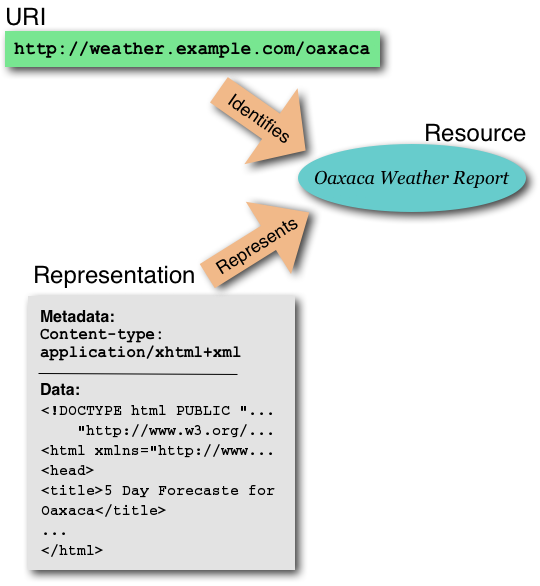Blogs as Web Applications
(17) Blog in XML
<?xml version="1.0" encoding="UTF-8"?>
<blogxml>
<post date="2006-05-25">
<title>Holyrood Park</title>
<text>Located in the middle of Edinburgh, Holyrood Park is a hill with a lot of rock and grass.</text>
<image src="holyrood-park">View from the west with the most spectacular cliffs.</image>
</post>
<post date="2007-05-15">
<title>Half Dome</title>
<text>The trip to half dome is a long one, but very beautiful and with a spectacular final climb.</text>
<image src="half-dome">Me on top of half dome.</image>
</post>
<post date="2007-05-20">
<title>Fifth Lake</title>
<text>The seven lakes loop offers views of (surprise!) seven lakes settled in a remote valley.</text>
<image src="fifth-lake">Still a lot of ice on fifth lake.</image>
</post>
<post date="2007-05-22">
<title>Golden Canyon</title>
<text>Golden Canyon leads to the famous Zabriskie Point overlook.</text>
<image src="golden-canyon">A maze of erosion patterns carved in sediment.</image>
</post>
<post date="2007-08-12">
<title>Red Rock Canyon</title>
<text>Red Rock Canyon is easily reachable from Las Vegas and has some nice trails.</text>
<image src="red-rock-canyon">Red Rock Canyon is called Red Rock Canyon for a reason.</image>
</post>
</blogxml>
(18) Support URI Guessing (Year Index)
<xsl:for-each select="distinct-values( for $i in //post/@date return substring($i, 1, 4) )">
<xsl:result-document href="dretblog/{current()}/index.html">
<html>
<head><xsl:sequence select="dret:head(format-date(xs:date(concat(current(), '-01-01')), '[Y]'), '../')"/></head>
<body>
<h1><a href="..">dretblog</a></h1>
<h2><xsl:value-of select="format-date(xs:date(concat(current(), '-01-01')), '[Y]')"/></h2>
<xsl:for-each select="$stdin//post[starts-with(@date, current())]">
<p><a href="../{translate(@date, '-', '/')}/{dret:postname(title)}"><xsl:value-of select="concat(format-date(@date, '[F] [MNn] [D], [Y]'), ': ', title)"/></a></p>
</xsl:for-each>
</body>
</html>
</xsl:result-document>
</xsl:for-each>(19) Support URI Guessing (Month Index)
<xsl:for-each select="distinct-values( for $i in //post/@date return substring($i, 1, 7) )">
<xsl:result-document href="dretblog/{translate(current(), '-', '/')}/index.html">
<html>
<head><xsl:sequence select="dret:head(format-date(xs:date(concat(current(), '-01')), '[MNn] [Y]'), '../../')"/></head>
<body>
<h1><a href="../..">dretblog</a></h1>
<h2>
<xsl:value-of select="format-date(xs:date(concat(current(), '-01')), '[MNn] ')"/>
<a href="../.."><xsl:value-of select="format-date(xs:date(concat(current(), '-01')), '[Y]')"/></a>
</h2>
<xsl:for-each select="$stdin//post[starts-with(@date, current())]">
<p><a href="../../{translate(@date, '-', '/')}/{dret:postname(title)}"><xsl:value-of select="concat(format-date(@date, '[F] [MNn] [D], [Y]'), ': ', title)"/></a></p>
</xsl:for-each>
</body>
</html>
</xsl:result-document>
</xsl:for-each>(20) Support URI Guessing (Day Index)
<xsl:for-each select="distinct-values(//post/@date)">
<xsl:result-document href="dretblog/{translate(current(), '-', '/')}/index.html">
<html>
<head><xsl:sequence select="dret:head(format-date(xs:date(current()), '[F] [MNn] [D], [Y]'), '../../../')"/></head>
<body>
<h1><a href="../../..">dretblog</a></h1>
<h2>
<xsl:value-of select="format-date(xs:date(current()), '[F] ')"/>
<a href=".."><xsl:value-of select="format-date(xs:date(current()), '[MNn]')"/></a>
<xsl:value-of select="format-date(xs:date(current()), ' [D], ')"/>
<a href="../.."><xsl:value-of select="format-date(xs:date(current()), '[Y]')"/></a>
</h2>
<xsl:for-each select="$stdin//post[starts-with(@date, current())]">
<p><a href="../../../{translate(@date, '-', '/')}/{dret:postname(title)}"><xsl:value-of select="concat(format-date(@date, '[F] [MNn] [D], [Y]'), ': ', title)"/></a></p>
</xsl:for-each>
</body>
</html>
</xsl:result-document>
</xsl:for-each>(21) Support Spontaneous Navigation
<body>
<h1><xsl:value-of select="title"/></h1>
<h2>
<a href="./"><xsl:value-of select="format-date(@date, '[F]')"/></a>
<xsl:text> </xsl:text>
<a href=".."><xsl:value-of select="format-date(@date, '[MNn]')"/></a>
<xsl:text> </xsl:text>
<a href="./"><xsl:value-of select="format-date(@date, '[D]')"/></a>
<xsl:text>, </xsl:text>
<a href="../.."><xsl:value-of select="format-date(@date, '[Y]')"/></a>
</h2>
<a href="../../../../../img/{image/@src}.jpg" title="{image}"><img src="../../../../../img/{image/@src}-small.jpg"/></a>
<p><xsl:value-of select="text"/></p>
</body>(22) Publishing as Atom Feed
<feed xmlns="http://www.w3.org/2005/Atom" xml:base="http://dret.net/lectures/web-fall09/src/dretblog.atom">
<title>dretblog</title>
<id>http://dret.net/lectures/web-fall09/src/dretblog.atom</id>
<link rel="self" href=""/>
<updated><xsl:value-of select="current-dateTime()"/></updated>
<author><name>Erik Wilde</name></author>
<xsl:for-each select="//post">
<entry xml:base="http://dret.net/lectures/web-fall09/src/{translate(@date, '-', '/')}/{dret:postname(title)}">
<title><xsl:value-of select="title"/></title>
<link href="http://dret.net/lectures/web-fall09/src/{translate(@date, '-', '/')}/{dret:postname(title)}"/>
<id><xsl:value-of select="concat('http://dret.net/lectures/web-fall09/src/', translate(@date, '-', '/'), '/', dret:postname(title))"/></id>
<published><xsl:value-of select="@date"/>T00:00:00Z</published>
<updated><xsl:value-of select="current-dateTime()"/></updated>
<content type="xhtml">
<div xmlns="http://www.w3.org/1999/xhtml">
<h1><xsl:value-of select="title"/></h1>
<h2><xsl:value-of select="format-date(@date, '[F] [MNn] [D], [Y]')"/></h2>
<a href="http://dret.net/lectures/web-fall09/img/{image/@src}.jpg" title="{image}"><img src="http://dret.net/lectures/web-fall09/img/{image/@src}-small.jpg"/></a>
<p><xsl:value-of select="text"/></p>
</div>
</content>
</entry>
</xsl:for-each>
</feed>(23) Blog as Atom Feed
<feed xmlns="http://www.w3.org/2005/Atom" xml:base="http://dret.net/lectures/web-fall09/src/dretblog.atom">
<title>dretblog</title>
<id>http://dret.net/lectures/web-fall09/src/dretblog.atom</id>
<link rel="self" href=""/>
<updated>2007-08-30T00:52:27.718-07:00</updated>
<author>
<name>Erik Wilde</name>
</author>
<entry xml:base="http://dret.net/lectures/web-fall09/src/2006/05/25/holyrood_park">
<title>Holyrood Park</title>
<link href="http://dret.net/lectures/web-fall09/src/2006/05/25/holyrood_park"/>
<id>http://dret.net/lectures/web-fall09/src/2006/05/25/holyrood_park</id>
<published>2006-05-25T00:00:00Z</published>
<updated>2007-08-30T00:52:27.718-07:00</updated>
<content type="xhtml">
<div xmlns="http://www.w3.org/1999/xhtml">
<h1>Holyrood Park</h1>
<h2>Thursday May 25, 2006</h2>
<a href="http://dret.net/lectures/web-fall09/img/holyrood-park.jpg" title="View from the west with the most spectacular cliffs.">
<img src="http://dret.net/lectures/web-fall09/img/holyrood-park-small.jpg"/>
</a>
<p>Located in the middle of Edinburgh, Holyrood Park is a hill with a lot of rock and grass.</p>
</div>
</content>
</entry>![]() [http://creativecommons.org/licenses/by/3.0/]
[http://creativecommons.org/licenses/by/3.0/]